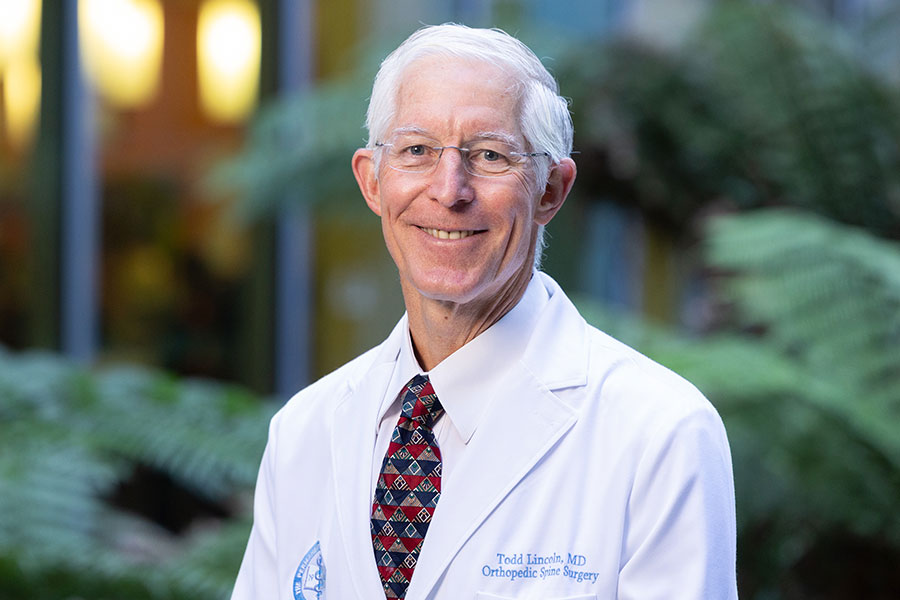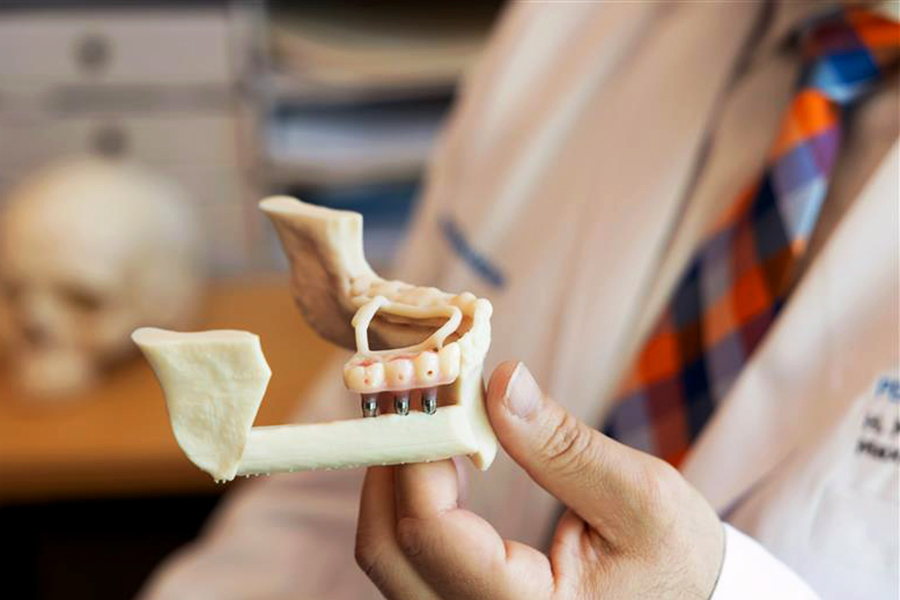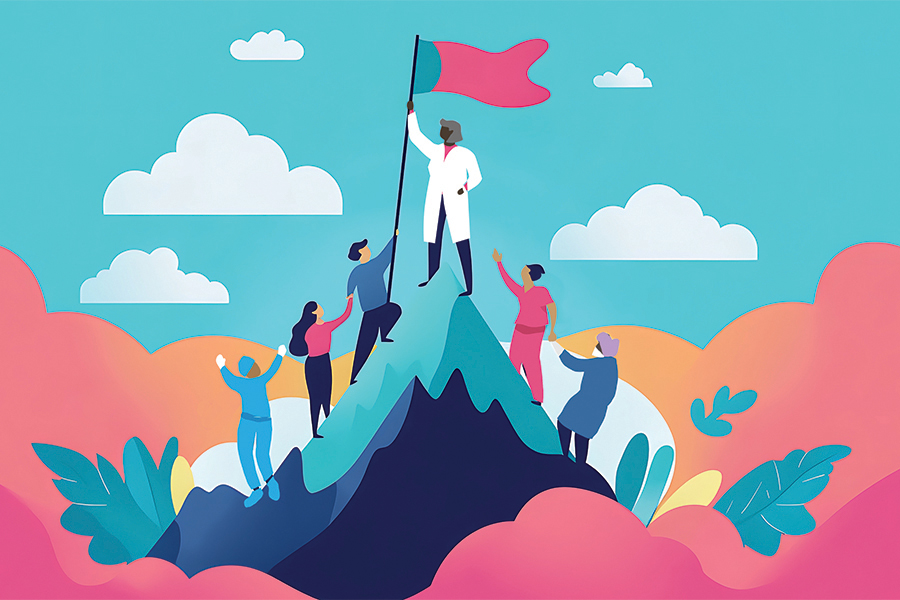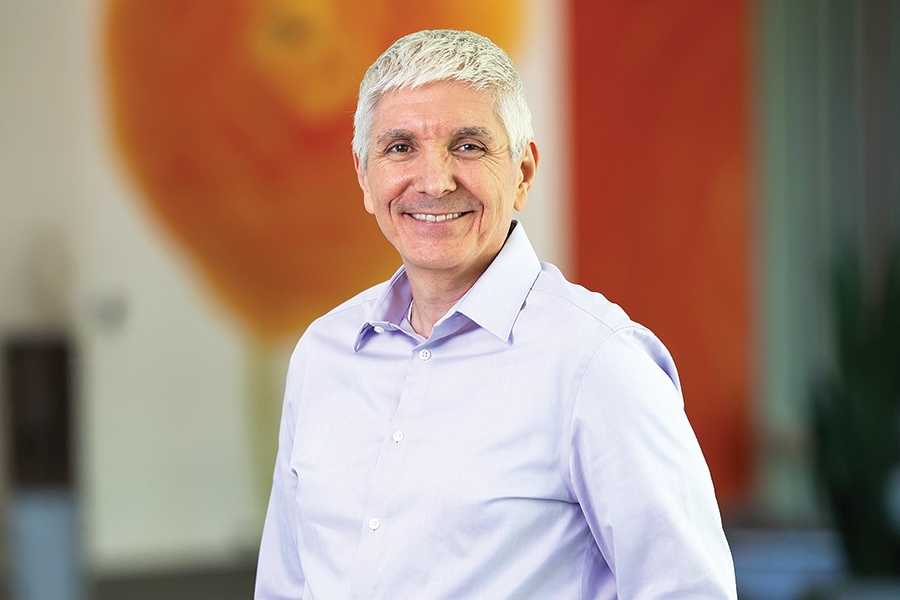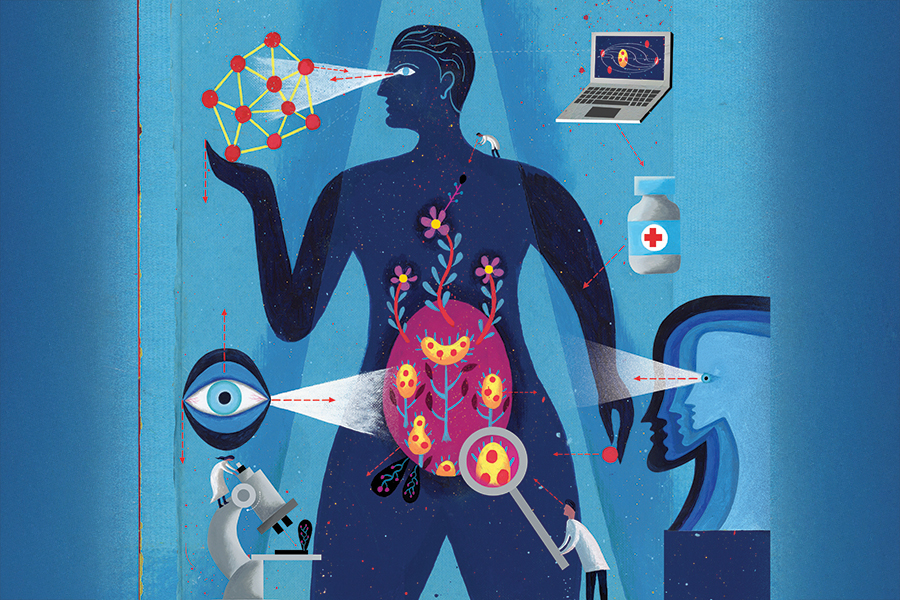A Q&A with Todd Lincoln, MD, a pediatric orthopedist who helped create a scoliosis surgery service for children in Kaiser Permanente Northern California.
December 20, 2024
In the nearly two decades since Todd Lincoln, MD, joined The Permanente Medical Group (TPMG), he’s helped thousands of children stand taller and move more comfortably. But he is perhaps best known for helping to create a regional, multidisciplinary specialty practice for scoliosis surgery at Kaiser Permanente (KP) Oakland.
Scoliosis is the most common pediatric spinal deformity, affecting about 3% of American children and adolescents. Although it can be caused by conditions such as muscular dystrophy or cerebral palsy, in most cases the cause is idiopathic, or unknown. Spinal fusion surgery is the typical treatment for more severe cases and is often a permanent fix for the condition.
Dr. Lincoln’s many contributions include helping develop an inpatient care pathway for scoliosis surgery and assembling a consistent, dedicated team of clinicians large enough to meet the needs of the KP Northern California region, says Sean McNatt, MD, regional director for pediatric surgical specialties and a pediatric neurosurgeon at KP Roseville.
“Dr. Lincoln is a compassionate, humble, and tireless surgeon who is well known and respected by his peers within and beyond Kaiser Permanente,” Dr. McNatt says. “He has our patients’ interests front and center, and patients and their families always have wonderful things to say about him. He earns their confidence, and they know they’re in great hands.”
Permanente Excellence spoke recently with Dr. Lincoln about his work, his history of international volunteering, and his planned retirement in early 2026.
Q: Tell us about your journey to become a pediatric orthopedic surgeon. What made you want to be a doctor? What inspired you to pursue your specialty?
A: The simple answer is the altruistic nature of medicine. Physicians are driven by helping patients, and I wanted to do the same. Physicians also get a great deal of personal satisfaction and appreciation in the practice of medicine, perhaps more so than one might in other careers, which is motivating. I also was attracted to the intellectual aspects of medicine — our field is always evolving and presenting new challenges.
What brought me to orthopedics is the diversity of problems we face in the specialty. These range from developmental issues and congenital disorders to neuromuscular problems, genetic syndromes, and trauma. In pediatric orthopedics, we have the additional variable of growth and how it factors into care, which I find fascinating. I also enjoy taking care of kids. They’re a motivated and optimistic group of patients. And I appreciate the physicality of performing spine surgery. It requires a lot of endurance and stamina because these surgeries take six to eight hours to complete.
Q: What drew you to The Permanente Medical Group?
A: I believe in TPMG’s focus on aligning our goals with those of the patient, and our commitment to delivering integrated, coordinated care. I also find that there’s a certain lack of ego for most of us who’ve joined TPMG. We don’t have to be rock stars on the internet, and we don’t have to go out and advertise ourselves. This was very appealing to me. And TPMG is transparent in how physicians are treated. I feel I’m treated equally to the other people in my department, and that’s something I really appreciate.
Q: How has your focus within your specialty evolved over the course of your career?
A: When I first joined TPMG in 2006, I was the sole pediatric orthopedist at the Oakland Medical Center, so I did everything except hand surgery, which is a separate specialty. I liked the variety of the practice and the opportunity to solve lots of different anatomic problems. When we brought on two additional pediatric orthopedists there, the first in 2016 and the second in 2019, it gave me the opportunity to focus exclusively on what I enjoy doing most — spinal deformity surgery.
Spine surgery is very mechanical, in the sense that you’re inserting screws and rods, and it dramatically changes the shape of a child’s body. These patients arrive at 6:30 in the morning for surgery, and by the afternoon they look very different: they’re taller, they’re straighter. It’s a permanent and immediate change. It’s typically a single surgery, and it lasts a lifetime.
Q: What types of spinal deformities do you treat, and what effects do these conditions have on children as they age?
A: The primary spinal deformities in pediatrics are scoliosis and kyphosis. Scoliosis is a side-to-side C- or S-shaped deformity, whereas kyphosis is a front-to-back, slouching deformity. The condition I see most often is adolescent idiopathic scoliosis, which develops later in childhood or early adolescence. Scoliosis is approximately 80 percent of my practice.
A central aspect of spinal deformity is that it’s a visual deformity. Most of these patients are otherwise healthy kids — they’re teenagers who swim and play volleyball and soccer, and they don’t want to look crooked. Childhood is a sensitive time for them developmentally, and a lot of mental health issues arise with kids who have scoliosis, including social anxiety and low self-esteem. About a third of kids with scoliosis have aching back pain that’s always in the background for them.
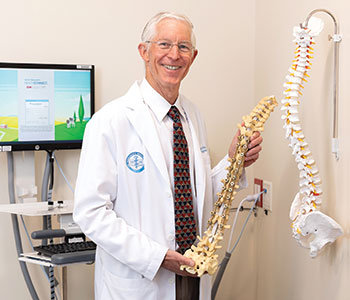
Dr. Lincoln holds a model of the hardware that keeps a section of the spine in a straight position after spinal fusion surgery for scoliosis.
Q: When is scoliosis surgery needed, and what are the primary goals of surgery?
A: We typically offer surgery when spinal curves have progressed to approximately 50 degrees. However, these decisions are not made purely by the numbers. I recommend surgery for some patients sooner, and some patients later, based on other factors, including whether they are having pain and how the condition is affecting their daily activities. But 50 degrees is the common threshold because medical literature suggests that curves of this size tend to slowly progress throughout adulthood. A smaller curve of 25 or 30 degrees typically stays stable.
Scoliosis is a rotational deformity, meaning that each vertebra spirals as it grows. A good analogy is to imagine wringing out a dish towel very tightly — it’ll eventually bow out into a curve. With surgery, we are able to straighten this curve, but it’s not a minimally invasive procedure. We have to expose and move the muscles off the spine, insert screws into each vertebra, contour a rod on either side of the spine, and then bring each vertebra to the rods and lock it in place. The primary goal for surgery is to stop the curve from getting worse, which alleviates pain, gives kids better quality of life, and improves how they feel about themselves. We’re also improving their deformity.
Q: You’ve helped build a well-known and highly respected specialty practice for pediatric scoliosis surgery within TPMG. How did the practice begin, and what are some of the key elements that help you and your team deliver outstanding care?
A: The service was started before I joined the organization by orthopedic surgeon Dr. Ravi Bains [KP Oakland], who has a great interest and expertise in spine deformity in children. He worked very hard to create a dedicated pediatric service. It has become more coordinated over time with other specialties, and we’ve become a larger, more consistent team. Each time we operate, we work with the same group of pediatric anesthesiologists, OR [operating room] nurses, OR techs, and neuromonitoring techs, which helps make everything go smoothly.
One of the key components of the program is a streamlined inpatient care pathway, which I helped develop alongside pediatric anesthesiologist Dr. Nicholas Riegels and pediatric hospitalist Dr. Marc Blumberg in 2017, who both practice at KP Oakland. We worked together to determine what each specialty should be looking for and doing at each step after surgery. So, for example, it’s clear what physical therapy should be doing on day one, day two, and so on, and how pain management changes each day.
A major benefit of the pathway is that we can preoperatively give patients and families an expectation of how recovery will progress. We can tell them, on day one, you’ll do this, on day two, you’ll do this, and then you might be going home that afternoon. Thanks to the pathway, hospital stays for pediatric scoliosis surgery have decreased from an average of 5 days in 2017 to 2.7 days today. Everybody providing care knows the pathway and reinforces it. This helps all of us be on the same page, and it makes care safer for patients. When a patient doesn’t complete a step of the pathway, we’re alerted, and we figure out why.
Q: Can you tell us more about the multidisciplinary team that supports patients?
A: It begins with clinicians in our Perioperative Medicine clinic, who prescreen every patient. It then carries into the OR, with all the different specialties that I mentioned involved. Then it continues on the pediatrics floor of the hospital with our pediatricians, physical therapists, nurses, and nutritionists. We’ve had a lot of cooperation and communication with the pediatricians, who play a critical role in how well these kids do postoperatively.
The pediatric floor nurses also deserve special recognition. When I joined TPMG, all our patients were transferred to the pediatric intensive care unit after surgery. Now, only the kids with neuromuscular conditions go to the PICU. All the other kids go directly to the pediatrics floor. It’s better care because it’s a much less stressful environment for the children and their families. And when our patients do well, we do well.
We also collaborate regularly with our pediatric neurosurgery team. We have joint conferences each month for educational purposes and to discuss and help each other with cases.
Q: International volunteer work has been a significant aspect of your career. Can you tell us about these medical missions?
A: Before joining TPMG, I practiced at Stanford University for 10 years, during which time I led weeklong trips with Operation Rainbow, an NGO [nongovernmental organization] based in the Bay Area that provides pediatric orthopedic care in Central and South America. I also used to go to China for two weeks a year and take care of kids in special-needs orphanages. When I first came here, I was still working with Operation Rainbow, and Dr. Bains went on a trip with me. He was very motivated by this journey and subsequently founded his own nonprofit, Standing Straight, which focuses solely on spine surgeries and works with a nonprofit hospital in northern India.
I stopped my trips with Operation Rainbow after my practice shifted exclusively to spine surgery, but the other pediatric orthopedists that joined TPMG after me are still leading these missions. I now work solely with Standing Straight, and I go once a year with a team to treat the most complex spinal deformities. A lot of the spine crew here at KP Oakland also goes. It’s our vacation time and it’s self-funded, so you can see that we’re really committed.
Q: Why is this volunteer work important to you? Are there any lessons that you’ve brought back to your practice here?
A: Volunteer surgical missions are a very direct means of giving back. The families that we help have no economic means to help their children otherwise. We provide complex care that can truly change the trajectory of these children’s lives by improving their physical health and eliminating the social stigma that often accompanies a physical deformity. The missions also provide education and training for the local health care teams, which elevates the quality of care available to people in those communities.
I don’t take home lessons necessarily, but the trips provide reminders of the differences in health care across the globe and how we should be grateful for what we have here. They are a very grounding experience, in that you don’t have to deal with any administrative work, and you’re just providing care. It’s a reminder for everyone who participates why they’re doing what they’re doing.
Q: What do you see on the horizon for the pediatric spine service in TPMG?
A: Our recent hire, pediatric orthopedist Dr. Daniel Bouton [KP Oakland], offers a newer surgical technique that can be helpful for some scoliosis patients. The standard surgery has the unintended consequence of decreased lower spinal mobility and flexibility because the spine is fused. With the newer technique that Dr. Bouton practices, a very thick polyethylene band connects the vertebrae on the convex side of the curve. As the child grows, this tethering prevents the spine from growing taller on the side with the band, but it allows the spine to continue growing taller on the concave side. So the effect of this newer technique is that kids can essentially un-grow their scoliosis. It’s not for everyone, but for 11- or 12-year-old children with enough spinal growth remaining, it can be a good choice.
I’m also hoping that we can have more of a national and international presence in the research arena. We have a great spine registry and a huge amount of data we can generate.
Q: We understand you plan to retire in early 2026. As you look back and reflect on your career, what have been some of the most rewarding aspects for you?
A: I’ve found a lot of meaning in the personal relationships I’ve made — with families, patients, and the people I work with. And in retirement I hope to increase my time volunteering with Standing Straight. I have to make sure that if I’m not doing surgeries day in and day out, that my skill set stays strong. Hopefully, I’ll be able to continue volunteering for many years.
Q: What legacy do you hope to leave behind in the organization?
A: I want the pediatric spine service to keep growing and improving. Dr. Bouton brings some new ideas, and I think ongoing self-assessment will help us to continue to match or exceed the care that’s provided elsewhere. We really do provide the highest level of surgical care for children with spinal deformities.
This article originally appeared in Permanente Excellence, the magazine for physicians in The Permanente Medical Group.


